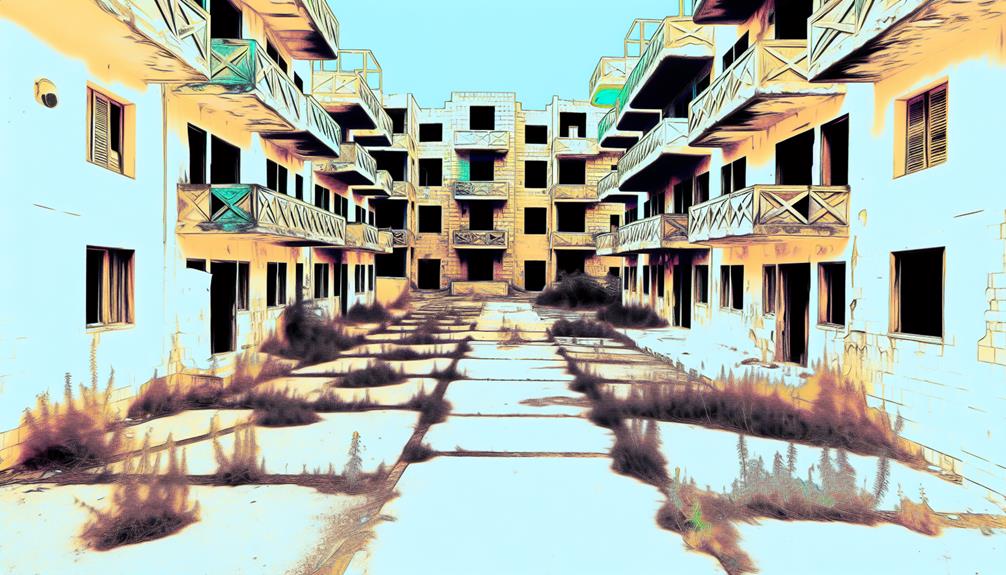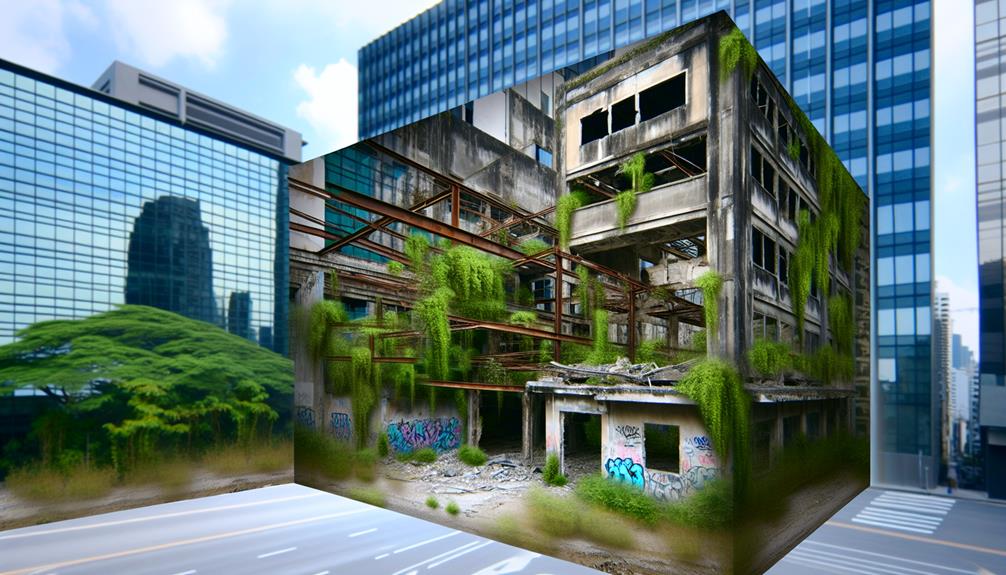Nestled on the coast of Cyprus, Varosha stands as a silent witness to the tumultuous history that has befallen the island. From its bustling streets filled with sun-seeking tourists to its current state of desolation, Varosha's narrative is both engaging and sorrowful. However, beyond its eerie facade lies a complex web of unresolved conflicts, legal intricacies, and a glimmer of hope for a future that could potentially alter the trajectory of this ghost city. The intricacies surrounding Varosha beckon further exploration into its past, present, and the possibilities that lie ahead.
Key Takeaways
- Varosha in Cyprus has been a ghost town since the 1974 Turkish invasion.
- Legal disputes over property ownership and status persist in Varosha.
- International actors like Greece, Turkey, and the UN are involved in Varosha's fate.
- Stalled reunification efforts complicate the status of Varosha.
- Competing interests and tensions impact the future of Varosha.
History of Varosha
Historically, Varosha in Cyprus has been a significant area with a rich past that dates back centuries. During the Ottoman rule, Varosha, known as Maraş in Turkish, flourished as a vibrant town. The Ottomans brought stability to the region, fostering trade and cultural exchange. Under Ottoman rule, Varosha became a melting pot of different cultures and traditions, which laid the foundation for its diverse identity.
In addition to the Ottoman influence, Varosha also experienced colonial influence from various powers, including the Venetians and the British. These colonial powers left their mark on the architecture and governance of the region. The Venetians, known for their strategic interest in Cyprus, constructed fortifications in Varosha to protect against potential invasions. The British, who later ruled Cyprus, further shaped Varosha's urban landscape, introducing modern infrastructure and institutions.
The blend of Ottoman and colonial influences created a unique tapestry of history in Varosha. The town became a hub of commerce and culture, attracting merchants, artisans, and intellectuals from across the Mediterranean. This rich historical background laid the groundwork for Varosha's future development and prosperity.
Varosha's Golden Era
During Varosha's Golden Era, the town experienced unprecedented economic growth and cultural flourishing that solidified its reputation as a paramount center of trade and innovation in the region.
The economic prosperity of Varosha during this period was driven by its strategic location as a bustling port city, facilitating vibrant trade routes that connected the town to various parts of the Mediterranean. This led to a surge in wealth accumulation, attracting merchants, entrepreneurs, and investors who contributed to the town's economic boom.
Moreover, Varosha's Golden Era was characterized by a rich tapestry of cultural diversity. The town became a melting pot of different ethnicities, languages, and traditions, fostering a climate of tolerance and exchange. This cultural mosaic not only enhanced the town's social fabric but also fueled creativity and innovation across various sectors. Varosha emerged as a hub of artistic expression, intellectual discourse, and technological advancements, drawing in scholars, artists, and visionaries from far and wide.
The convergence of economic prosperity and cultural diversity during Varosha's Golden Era laid the foundation for the town's prominence and resilience. It cultivated a dynamic environment where ideas flourished, businesses thrived, and people from all walks of life found opportunities for growth and prosperity.
Turkish Invasion of Cyprus
The tranquility of Varosha's Golden Era was abruptly shattered by the Turkish invasion of Cyprus, a pivotal event that dramatically altered the town's fate and left a lasting impact on its residents and infrastructure. The Turkish military intervention in Cyprus occurred in 1974 in response to a coup aimed at unifying the island with Greece. As a result, Varosha, once a thriving tourist destination known for its luxury hotels and beautiful beaches, became a ghost town almost overnight.
The consequences of the Turkish invasion were profound. Varosha's residents were forced to flee their homes, leaving behind their belongings and memories. The town, once bustling with life, became eerily silent, with empty buildings and deserted streets. The infrastructure that had supported Varosha's tourism industry fell into disrepair, with hotels and businesses left abandoned.
The impact of the Turkish invasion on Varosha continues to be felt to this day. The town remains fenced off and inaccessible, frozen in time as a stark reminder of the events that unfolded in 1974. The once-vibrant streets now stand as a haunting symbol of the consequences of conflict and the lasting scars it can leave on a community.
Abandonment and Frozen in Time
Symbolizing a poignant stillness, Varosha stands as a forsaken relic frozen in time, bearing witness to the enduring aftermath of the Turkish invasion of Cyprus in 1974. Once a vibrant and luxurious resort city on the island of Cyprus, Varosha now lies abandoned, encapsulating a haunting sense of urban decay. This ghost town, surrounded by barbed wire and warning signs, has become a symbol of the unresolved conflicts that plague the region.
Urban exploration of Varosha is both alluring and eerie. Visitors can witness the remnants of a bygone era frozen in time – hotels, restaurants, and shops that were abruptly deserted over four decades ago. The streets, once bustling with life, now stand empty, overgrown with vegetation reclaiming its territory. The eerie silence of Varosha serves as a stark reminder of the human cost of conflict and political unrest.
The concept of a once-thriving city now abandoned and off-limits to its former inhabitants raises ethical questions and stirs controversies. The fate of Varosha remains a contentious issue in the ongoing negotiations between Greek Cypriots and Turkish Cypriots. As Varosha continues to remain frozen in time, it stands as a somber indication of the consequences of war and the importance of seeking peaceful resolutions to conflicts.
Current Status and Controversies
Amid ongoing negotiations and diplomatic tensions, the current status of Varosha in Cyprus remains a subject of contentious debates and unresolved controversies. The following points shed light on the current developments and international tensions surrounding Varosha:
- Military Control: Varosha is under the control of the Turkish military since the 1974 conflict. This military presence has been a significant point of contention, with calls for demilitarization to facilitate the return of Varosha to its former residents.
- Legal Disputes: Legal disputes persist regarding the ownership and status of properties in Varosha. Efforts to address these issues through legal channels have been complicated by the political divide on the island.
- International Involvement: Various international actors have expressed interest in the future of Varosha. The involvement of countries such as Greece, Turkey, and the United Nations reflects the complex web of international tensions surrounding the region.
- Stalled Reunification Efforts: Despite multiple attempts to reunify Cyprus, progress has been slow. Varosha's status has been a sticking point in these negotiations, with conflicting visions for its future complicating efforts to reach a resolution.
The interplay of these factors underscores the challenges in determining the fate of Varosha amidst the backdrop of international tensions and competing interests.
Future Prospects and Preservation
Considering the complex historical and geopolitical context surrounding Varosha in Cyprus, the future prospects and preservation of this region pose significant challenges requiring careful deliberation and strategic planning. Preservation challenges in Varosha stem from the unresolved political situation and the long-standing division of Cyprus. The region has been abandoned since the Turkish invasion of Cyprus in 1974, leading to issues such as environmental degradation, property rights disputes, and the erosion of cultural heritage.
Addressing the preservation challenges in Varosha necessitates a multi-faceted approach that balances environmental concerns, cultural heritage preservation, and sustainable development. Efforts to restore Varosha must involve collaboration between the relevant stakeholders, including the Republic of Cyprus, the Turkish Cypriot authorities, and the international community.
Despite the preservation challenges, Varosha also presents economic development opportunities that could benefit both communities in Cyprus. The region's strategic location, beautiful coastline, and historical significance offer potential for tourism development, real estate investment, and cultural revitalization. By leveraging these economic opportunities in a sustainable manner, Varosha could become a symbol of peace, reconciliation, and prosperity for the entire island.
Frequently Asked Questions
Is It Safe to Visit Varosha, Cyprus?
When considering the safety of visiting a specific location, it is essential to research current conditions, adhere to recommended safety precautions, and evaluate the availability of local accommodations.
Prioritizing personal safety, following travel advisories, and staying informed about potential risks can contribute to a secure experience.
Understanding the local environment and having access to suitable accommodations can enhance the overall travel experience while ensuring a comfortable stay.
What Are the Environmental Impacts of Varosha's Abandonment?
The abandonment of an urban area can lead to significant ecological degradation, impacting wildlife preservation efforts. As nature reclaims the space, invasive species can thrive, disrupting local ecosystems.
This shift in habitat dynamics can negatively affect native flora and fauna, leading to a decline in biodiversity. Addressing these environmental impacts requires strategic planning and intervention to mitigate the long-term consequences of urban abandonment on wildlife and their habitats.
Are There Any Plans to Restore Varosha's Infrastructure?
Plans for infrastructure restoration are underway, aiming to revitalize the area's development. The future prospects involve rejuvenating the urban environment, enhancing accessibility, and promoting sustainable growth.
These efforts seek to address the current state of disrepair and create opportunities for economic revitalization. The focus on infrastructure projects in Varosha reflects a commitment to restoring the area's functionality and attractiveness to residents and visitors alike.
How Has Varosha's Economy Been Impacted by Its Status?
Economic struggles have beset regions grappling with tourism decline, leading to a downturn in local businesses and employment opportunities.
The impact of such circumstances reverberates throughout the community, affecting livelihoods and overall prosperity.
This situation underscores the interconnectedness of a region's economic health with its tourism sector, highlighting the need for strategic interventions to revitalize and sustain economic growth.
Can Tourists Access Any Parts of Varosha for Sightseeing?
Tourist restrictions in certain areas may limit sightseeing opportunities due to safety concerns or preservation efforts. However, access to designated tourist sites and attractions is generally permitted for visitors.
Regulations may vary based on local policies and historical significance of the area. It is advisable for tourists to inquire about any restrictions or guidelines before planning their sightseeing activities to guarantee a smooth and enjoyable experience.
Conclusion
To sum up, Varosha's past prosperity, present plight, and potential for preservation paint a picture of promise amidst political complexities.
The ghost town's history holds lessons for the future, offering a glimpse of hope for cultural revitalization, tourism development, and reconciliation efforts.
The frozen city stands as a symbol of strife and resilience, awaiting a brighter tomorrow through peaceful resolutions and preservation initiatives.


